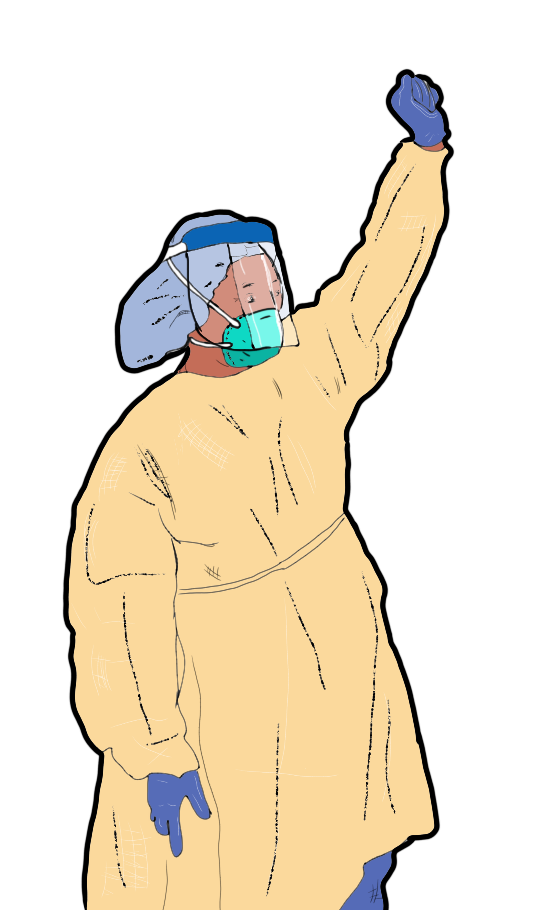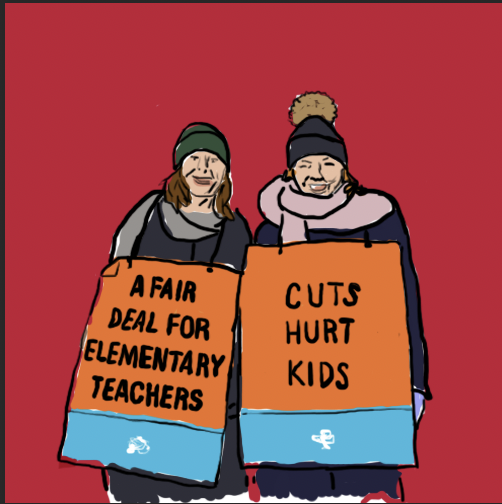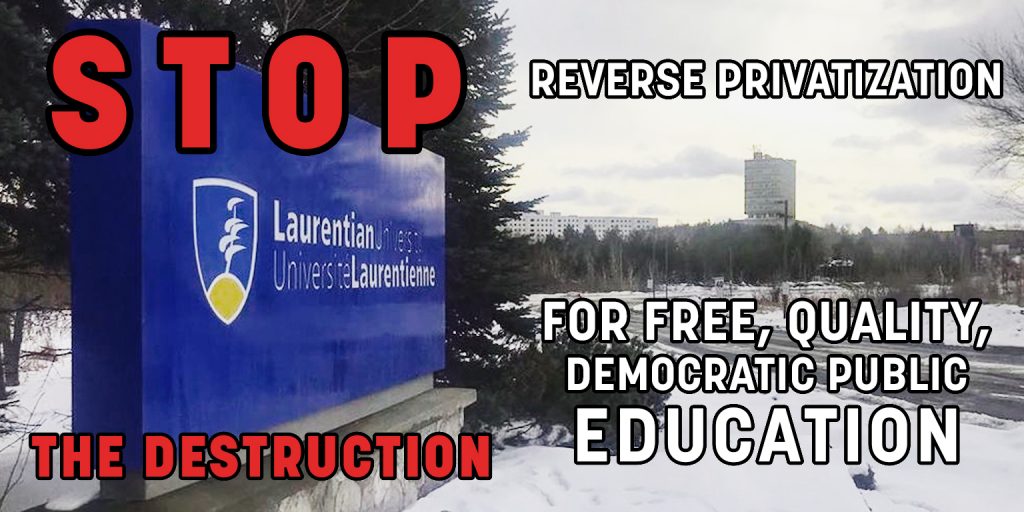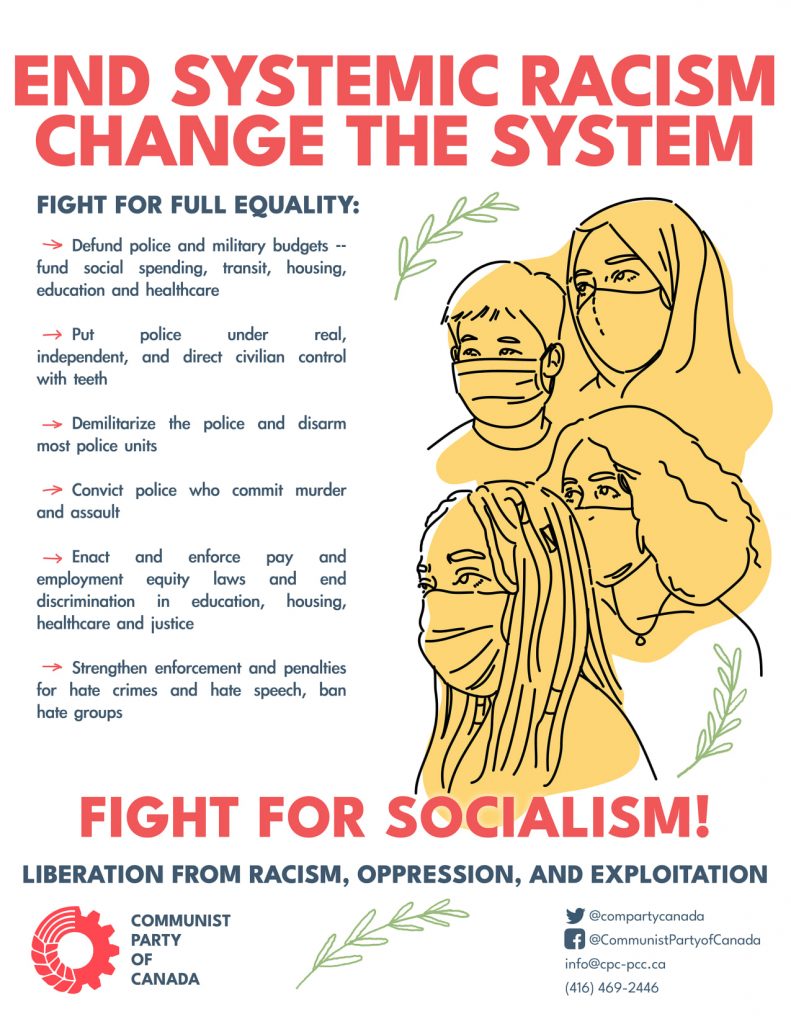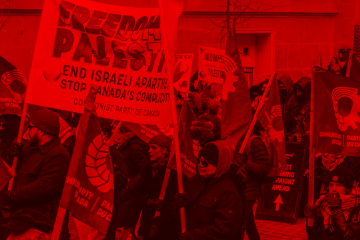The 31st Ontario Convention of the Communist Party of Canada was held online on November 27th and 28th, 2021. The following political report was amended and adopted unanimously.
A Global Capitalist Crisis
Ontario, Canada and the world is in the midst of a severe capitalist crisis: economic, ecological, the pandemic and widening devastation through imperialist war and sanctions.
In capitalist countries, including Canada, governments were unable to prevent or contain the health crisis while maintaining corporate power and profits. The main strategy of these governments was to bail out the corporations and transfer immense wealth from working people to a faltering capitalist system, and to maintain control despite the ballooning numbers of unemployed workers.
As the Communist Party of Canada pointed out during the September federal election:
“This summer has seen record-shattering heat waves, the discovery of unmarked graves of Indigenous children, and growing imperialist war threats. The COVID-19 pandemic and the economic crisis together have caused over 26,000 deaths in Canada, brought hospitals and healthcare workers to the verge of collapse, and left millions of workers precariously employed or jobless – their savings exhausted, their future uncertain. The capitalist system and the genocidal legacy of colonialism offer no future – it’s time for fundamental change.”
The crisis has increased the objective base for ultra-right and fascist movements that have formed government in dozens of countries and whose movements are growing here in Canada. The crisis has also provided the catalyst for the growth of revolutionary and progressive movements including the Communist Party of Canada and movements around the world.
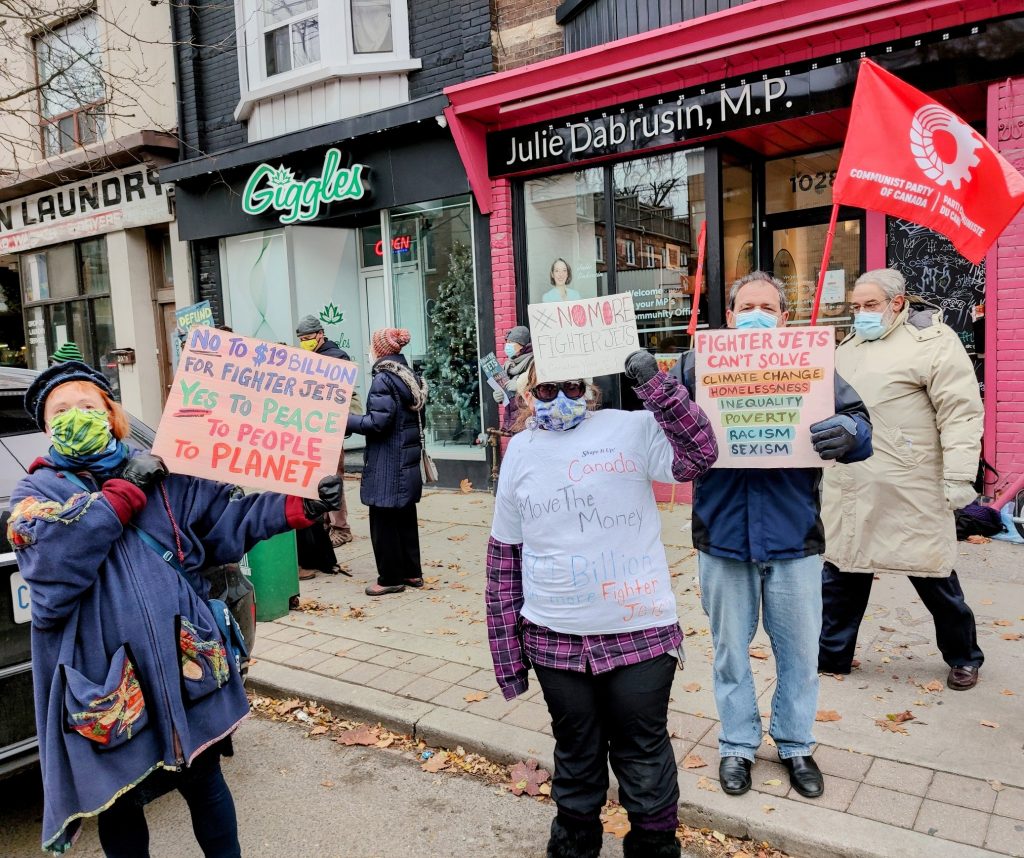
The economic recovery envisioned by imperialism relies on militarism and war. The international situation during this crisis requires a clear class perspective – the main enemy is at home.
The threat of war is growing everywhere. During the pandemic, the United States’ government has opportunistically strengthened regime change operations against countries like Venezuela, Iran, and Nicaragua with increased sanctions and provocations. Canada too has participated in the campaigns against these governments and has also interfered and supported reactionary elements in countries such as Haiti. The latest U.S. offensive against Cuba is a brazen attempt to stamp out socialism in the Western hemisphere, something that we cannot let happen. The new Cold War against China has escalated considerably since our last Convention. It is clear that the Communist Party needs to double our efforts in building anti-war and solidarity movements.

A People’s Alternative is needed now more than ever. As the Central Committee of the Communist Party of Canada wrote in early 2021:
“We need to seize the moment to fight for a fundamentally different, and more progressive direction for Canada, that blocks the far-right, curbs corporate power, and enacts fundamental economic and social change, that will open the door to socialism. We need to build a People’s Coalition that can fight for this new direction, that can fight for a People’s Agenda, an independent foreign policy of peace and disarmament, that fights for climate justice, that fight for multi-lateral and mutually beneficial trade with the world, and that fights for a Canadian economy based on full employment policies, with value added jobs in manufacturing and secondary industries, in public transportation, public services, and in supply management systems of family farming.”
It was the task of Ontario’s 31st Convention to apply the political line set out by the Central Convention and Central Committee to the particular manifestations of the capitalist crisis in Ontario. In addition to organizing the Party in Ontario to carry out the international and Canada-wide initiatives set by the Central Party, our Convention has played an important role in discussing and analysing the nature of the corporate attack in Ontario.
The Corporate Attack in Ontario
The COVID-19 Pandemic & Ontario
The COVID-19 pandemic has shone a spotlight on capitalist governments’ inability to put people’s health before short-term profits. Canada was a world leader in terms of long-term care deaths, and a Summer 2021 study published by the Royal Society of Canada showed that the real death toll is likely double the officially reported 30,000+ deaths. More people in Canada have died from COVID-19 than those that died in World War II. Whether the actual toll is 30,000 or 60,000 lives lost, this horrendous loss of life was entirely avoidable if public health interests were not made to compete with profit. These deaths represent victims of capitalism and their blood is on the hands of Bay street and the federal and provincial governments, not least of all the Ford government in Ontario.
Unlike the socialist countries and even a few capitalist governments, Canada and Ontario’s strategy from the beginning was not to take decisive action to halt COVID-19’s spread and defeat it, but to exclusively “flatten the curve” among the population while minimizing the inconvenience to capital. Essentially this meant that the goal was to keep the disease at a slow boil so the healthcare system would not spill over and collapse creating further economic and social crises. From the beginning and for well over a year, the strategy was to keep the death toll at an “acceptable” level while most production continued and new “COVID Relief” schemes created even bigger profits for the banks and the largest corporate monopolies. Canada and Ontario announced this strategy publicly and from their perspective their response to the pandemic was not a failure but all part of the plan.
Other countries showed that it was possible to stop community spread of the disease, but only by taking swift and decisive action. Countries and jurisdictions that did well used policies such as providing free shelter to those testing positive to avoid other family members getting sick, ensuring everyone quarantining has access to food, providing universal income supports to those affected by lockdowns, cancelling rent, mortgage and debt payments, and mobilizing mass testing and contact tracing through major expansions of health care and public health. Most of these policies were not on the table in Canada or Ontario, as neoliberal ideology and capitalism constrained politicians at both levels of government.
Throughout the pandemic the Ford government consistently sided with corporate interests whenever they conflicted with human health. While repeatedly lying that he was listening to public health officials, Doug Ford did not approve a properly funded response and ensured that lockdowns were largely ineffective and toothless. In the end they dragged on for many months in much of Ontario. The government only pretended to use science and public health experts in determining policy. Objectively, this helped fuel a huge rise in anti-mask, anti-lockdown and anti-vaccination movements which were directly connected to growing ultra-right and fascist organizations in the province.
As the province prepares for next spring’s election, we should ensure that the Ford government cannot present a revisionist history of the pandemic. They need to be held to account for being the virus’ consistent ally, leading to thousands of preventable deaths. For this reason, we should be clear and specific about this government’s actions and inactions. This is a list of some of the most egregious examples of this government’s pandemic related crimes against the people of Ontario:
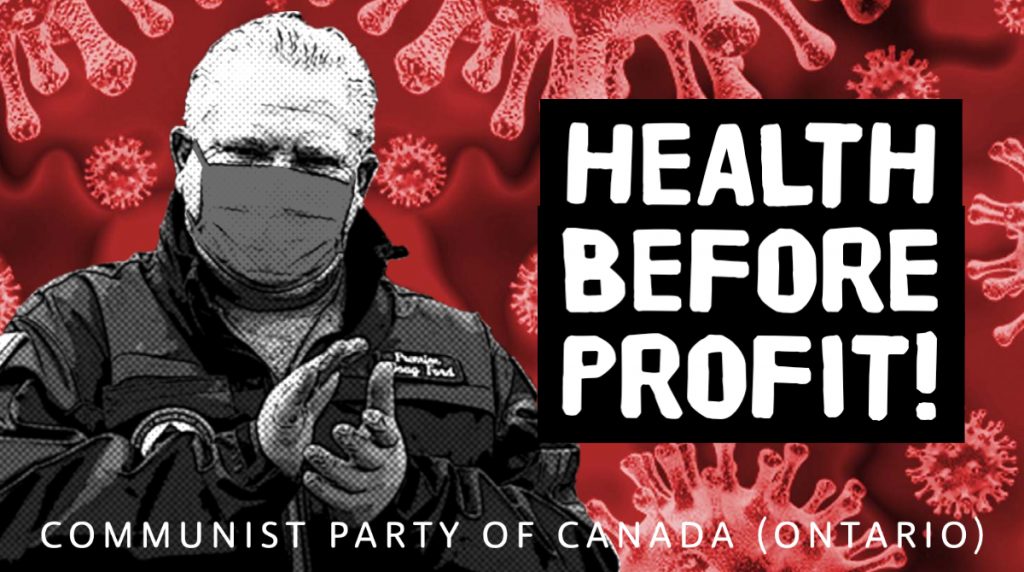
Policies promoting mass death and misery in long-term care
The Ford government, itself a revolving door to the for-profit long-term care sector, failed to address the systemic problems in LTC. After the first wave, during which thousands of residents and staff had died, they failed to take effective measures to prevent more deaths that came with the second wave. During the first wave, we found out that the Ford government had cancelled all comprehensive annual surprise inspections to LTC homes when they took office. Ford has still made no commitment to renew these inspections. Despite such short staffing that the army needed to be deployed to several homes in spring 2020, there was no real effort to recruit PSWs to meet the demands of the second wave. As anticipated, more mass death ensued. In November 2020, well into the second wave, the Ford government announced a minimum standard of care of 4-hours, which public health advocates had been demanding for more than two decades. However, this will not be implemented until 2024/25 and there is still no plan to recruit adequate numbers of staff.
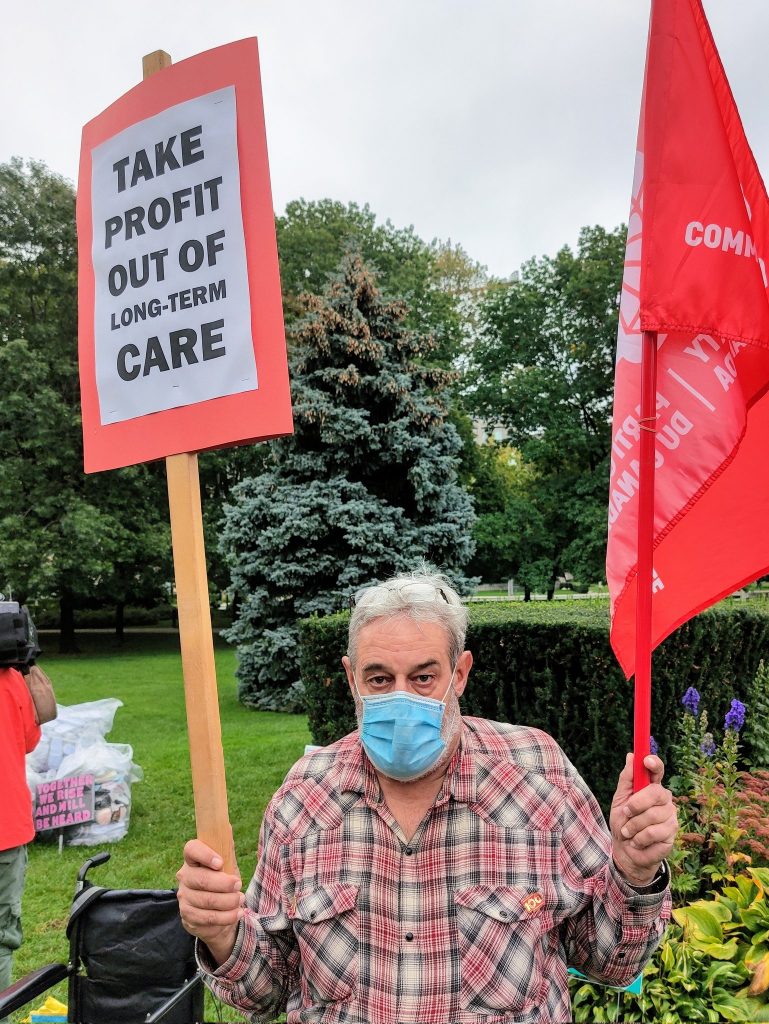
The Ford government shielded LTC profiteers from any accountability. For-profit LTC homes had double the death rate of non-profits and five times the death rate of the public (municipal) homes. It was clear that for-profit homes siphoned profits from public funding and resident fees away from quality of care, safety and staff wages. The majority of the public recognized this, and polls supported making all LTC publicly-owned and operated. Just as the second wave began in November, the government passed Bill 218 which made it more difficult for residents and their families to take any legal action against homes for negligence and harm resulting from COVID-19. Not only were these homes protected from penalty, but some of the worst for-profit LTC chains were rewarded with new 30-year licences and expansions in 2021.
Not nearly enough funding for safe schools
In September 2020, Doug Ford and Education Minister Lecce used a report by SickKids Hospital to say a safe return to in-person learning was possible. However, they did nothing to enact many of the recommendations of that same report, including reduced class and cohort size in order to allow for physical distancing. Ford’s response to criticism was to publicly attack teachers and their unions for speaking out and to block the school board’s efforts to reduce class sizes. The government continued to downplay in-school transmission well into the third wave of the pandemic and continue to ignore calls from experts to provide the funds necessary to reduce class sizes and install proper ventilation.
Resisting real lockdowns meant more deaths and drawn-out and painful half-measures
In late October 2020, the Ford government, against the advice of Public Health Ontario, changed the criteria for moving from “orange” to “red” levels for public health measures from a test positivity rate of 2.5%to 10%. This 400% increase allowed indoor dining, gyms, karaoke, theatres and casinos to operate for a longer period leading to more spread and resulting in more deaths. Most epidemiologists and the Ontario Medical Association spoke out against this move.
Just after the second wave peak in mid-February 2021, Ontario’s Science Advisory Table presented modelling showing that any lifting of public health measures would quickly cause hospitalizations to peak again. Only four days after that announcement the government began easing restrictions and the stay-at-home order was lifted. By late March, the director of the Science Table was saying the “pandemic was completely out of control.” At the beginning of April, the modelling showed that a new stay-at-home order was necessary to flatten the curve. Immediately after that presentation, the government announced it would not enact a stay-at-home order and instead would permit non-essential retail to remain open.
In July 2021, the Toronto Star reported extensively on the network of Conservative lobbyists employed by the largest corporations in the province to gain exemptions to lockdowns. They secured these exemptions in key industries such as film, construction and big box retail. Over 2,550 Ontarians died between Feb 11 and July 1st. How many people would still be alive if the government had not chosen to ignore their own modelling?
No paid sick days cost countless lives
For over 13 months the government fought health experts on providing paid sick days to workers. During this time, most “essential” workers continued to go to work without access to paid sick days. They were under the looming threat of catching COVID-19 and as a result losing the income necessary for rent and groceries. Unions, youth and students, racialized communities, women’s groups and others formed a massive movement for paid sick days in Ontario, which included many of the same doctors and public health officials to whom the Ford government claimed they were listening to. Ford refused to address this straightforward demand until the health situation peaked and political pressure forced Ford into a week of hiding during the third wave. They then announced a temporary three-day government paid sick day program, a far cry from the necessary two-week permanent, employer-paid sick day program. With massive workplace outbreaks in meat packing, agriculture, manufacturing and warehouses, we may never know how many lives were traded for slightly larger corporate profits.
________
While the Ford government must be made accountable for the sickness and death they inflicted, we must not lose sight of the systemic roots of the health crisis caused by capitalism itself. The system’s perpetuation of sexism and racism in order to better exploit the working class as a whole was reflected in the health and economic outcomes of the pandemic. The disproportionate spread of the disease in racialized and working-class neighbourhoods is a prime example. In March 2021, Statistics Canada reported that the most racialized communities in Canada reported mortality rates more than twice as high as those reported by overwhelmingly white neighbourhoods. “Hot spots” were not random but were caused by racist inequality in employment, healthcare, services, and housing. Immigrant and racialized communities were more likely to be forced to work in “essential” low-paid, non-union and precarious employment and live in overcrowded housing with multi-generational families.
The treatment of migrant workers is another example. Beginning during the early outbreaks, agriculture businesses exploited temporary foreign worker schemes to gain travel exemptions for migrant farm workers to enter the country. In many cases, these workers were forced into working and living conditions which subjected them to high rates of infection, and which facilitated increased spread of the virus. The pandemic shone a spotlight on the need to fight systemic racism with higher wages, better working conditions and unionization rates, access to adequate housing and education along with the elimination of racist migrant temporary work programs to give all workers in Ontario the same legal rights.
The pandemic is still having a profound impact on women, especially but not only those who make up the majority of healthcare and other front-line workers. Statistics Canada data from 2018 indicate that women comprise 82% of health workers in Canada, nearly 10% higher than the global rate of 75%. In addition, women have had to disproportionately look after their children while day cares and schools are closed, with many juggling working from home and supervising online education. There was also a striking gender divide in job losses during the pandemic as the retail, hospitality and service sector was hit hard by lockdowns. The disproportionate impact of the economic crisis on women, whose participation in the labour force has fallen to a 30-year low, is rooted in the gendered division of labour in the workforce and the home under capitalism.
Quality, affordable child care is a key building block for a robust and equitable economy. The childcare system was problematic in Ontario long before COVID-19 and has only worsened since. Fees are unaffordable, often reaching well over a thousand dollars a month per child. Private commercial providers are often allowed to skimp on facilities, professional training and health and safety protocols, while municipal and not-for-profits are left underfunded. Aside from the cost, there’s an acute shortage of spaces – notably in big cities, and particularly in working class and racialized neighbourhoods. This is a huge challenge for families who have precarious jobs without a conventional 9-5 schedule. Many families are forced to rely on untrained neighbours and other unlicensed operators, with all the problems and dangers that entails. Women, of course, are unequally impacted by the lack of childcare options, since primary responsibility for child-rearing is typically left to them. It was mostly women who were forced to quit their jobs when schools closed during the pandemic, thus widening the chronic gender income gap. Ontario has not yet signed on to the federal Liberals’ promised program to lower fees, raise the wages of childcare workers, and expand the number of public and not-for-profit childcare spaces. The Tories are touting a tax-credit, private-provider approach – or even expect parents (especially women) to stay at home – which discriminates against working class communities.
According to Sick Kids Hospital, a recent poll found that roughly 70 percent of children experienced deterioration of their mental health during the pandemic. Another recent study found that women, people who have lost their jobs as a result of the pandemic, those who are worried about their personal finances, people with children at home and young people are more likely than others to experience symptoms of anxiety and depression at this time. This serious mental health crisis as well as the associated increase in substance use, comes at a time where funding for mental health is being cut back across the province. According to the CMHA, almost 80 percent of Ontarians now believe we will be in a serious mental health crisis post-pandemic. The results of this underfunding could be catastrophic. Public healthcare should be immediately expanded to include dental, pharmacare, mental health and addiction support services, long-term care and comprehensive care for all seniors.
Young workers faced massive job losses, no (or more precarious) summer employment for students, and higher risks because they work in front-line service jobs (groceries, restaurants, retail, etc. Many students dropped out of post-secondary education (PSE) entirely because of the pandemic restrictions, which increases mental stress and, in many cases, student debt as well because they are still paying living expenses for that extra year.
The pandemic has also revealed the depth of collusion among corporations, as when Canada’s huge grocery monopolies planned together about when to “throw a bone” to workers in the form of a small temporary raise and when to take it away.
While 5.5 million Canadian workers lost their jobs or had more than half their hours cut in the spring of 2020, not everyone was suffering equally. The wealth of Canada’s billionaires increased by $78 billion in a one-year period starting in March 2020. Federal and provincial policies were responsible for this mass transfer of wealth, often directly from public coffers to the largest corporations through programs like the Canadian Emergency Wage Subsidy (CEWS).
The opioid epidemic in Ontario has been seriously exacerbated by the impacts of the COVID-19 pandemic. Social distancing measures to limit the impacts of COVID-19 reduced service levels of health and social services for people who use drugs. Research conducted for the Ontario Drug Policy Research Network (ODPRN), shows that opioid-related deaths increased by 60% from 1,517 deaths in 2019 to 2,426 in 2020. There was an increase of 139% of opioid-related deaths among people experiencing homelessness. Almost 1 in 6 deaths were among this population. Deaths among people aged 25 to 44 increased by 82% with 501 more deaths than pre-pandemic. Both pre-pandemic and during the pandemic, roughly half of all opioid-related deaths were among people who were unemployed. In August 2020 Canada’s Minister of Health wrote an open letter to provinces and territories urging an increase in access to a safe supply of drugs.

Addiction and drug use is a health issue that should not be criminalized. Small steps have been made in the past years, but the approach and solution need to be standardized province wide. Addiction and poverty are tightly enmeshed, so non-medical, social support systems can also be extremely powerful in dealing with the social isolation aspects that catalyze many aspects of drug addiction. Dignified permanent housing solutions, comprehensive care treating the complex physical and mental health issues underlying opioid use disorder, safe supply of drugs, greater protections for workers to both prevent injuries that lead to opioid addiction and to provide support to those that do acquire injuries, and greater availability of services in rural and remote regions are some of the actions that need to be taken to address this crisis.
The attack on wages and living standards in Ontario
Wages and living standards for the vast majority continue to decline in Ontario due to deepening exploitation pushed by capital and facilitated by the provincial and federal governments. According to 2019 estimates, 1.57 million people in Ontario live in poverty, below the Low-Income Measure (LIM) including 400,000 children.
The Ontario Child Benefit and the Canada Child Benefit provided some modest relief in the last decade, however the reduction in child poverty was accompanied by a similar increase in poverty for single adults and families without children during the same period.
Bourgeois economists and politicians marvelled at the supposed bouncing back of the unemployment rate to 7.8% in June 2021, but they failed to mention that most jobs being created are part-time and much more precarious with lower wage rates. June 2021 saw 231,000 jobs created after third wave lockdowns ended in much of the country, however all of these jobs were part-time, while full-time work declined by 33,000 jobs.
This trend has been taking place since the 1990s. In 2015, a study by the Canadian Centre for Policy Alternatives found that the low-wage workforce in Ontario had grown by more than 90% over the past two decades, much faster than the overall 30% growth in total employment. Precarious jobs, often contract or temporary without benefits or pensions, have penetrated into all sectors of the economy, with more than 20% of workers in the professional field now working precariously.
The Ford government’s commitment to deepening corporate exploitation of labour can be seen clearly in some of the first steps his government took in 2018. They cancelled the $1 minimum wage increase to $15/hr, effectively transferring $1.3 billion slated to go to Ontario’s lowest paid workers which was instead redirected to some of the biggest employers. At the same time they forced through Bill 66, Ontario’s “Open for Business” bill, which introduced sweeping changes to benefit corporate profits and power. This included changes that reduced overtime pay and the regulation of overtime, lowered wages for unionized construction workers, reduced regulations on home-based day cares, reduced reporting of toxic substances in workplaces, and reduced regulation on wireless telecommunication and long-term care corporations. In addition, the pandemic has brought new attacks on workers. Many employers are exercising increased surveillance over employees whether they work from home or at employment sites. Employees have also been forced to return to work in unsafe conditions even as the pandemic numbers have fluctuated throughout the various waves we have been through. Ford’s Ontario is certainly open to deeper and deeper exploitation by business.
It is revealing that, since the beginning of the pandemic, increasing numbers of workers who left the workforce have remained out of it. There are several facets to this. Many of these workers are women who have been compelled to remain at home because of closures or restrictions at schools and daycares, or to provide additional care for family members. Others, particularly younger workers, have decided to not return to the low wages, lack of security and abusive working conditions of the current job market. The corporate media have dubbed this “The Great Resignation” and largely framed it in relation to its effects on small business owners and their experience of labour shortage. They have also unfairly implied that it is the result of a sense of “entitlement” among younger workers. While this phenomenon is a far cry from the “class conscious mass strike” that some left organizations make it out to be, it is a clear indication of the inadequacies of capitalism and the increasing restlessness of working people who suffer under them.

The lowest income Ontarians are on the Ford government’s hit list as well. Upon taking office, social assistance rates for Ontario Works (OW) and Ontario Disability Support Program (ODSP) were cut by cancelling the planned 3% increase and setting increases just below inflation. Social assistance had already been cut to the bone in the 1990s under the Harris government and then left to stagnate during the Liberal years. A single person on OW receives $733 a month while a person on ODSP receives $1,169 a month. Social assistance rates are less than half the income necessary for a basic standard of living. It is no wonder why the United Nations’ Special Rapporteur on the Rights of Persons with Disabilities deemed Ontario’s social assistance system fundamentally flawed in 2019.
In addition to cancelling increases, Ford cancelled the Wynne government basic income pilot project which increased social assistance payments to 4000 low income Ontarians. While the Communist Party criticized the pilot project at the time of the program’s creation as a way to strip out credits accessible through social assistance, the scrapping of the program and the maintenance of the status quo by the Ford government has just meant continued sub-poverty line incomes for those accessing OW and ODSP. The neo-liberal idea of a Universal Basic Income (UBI) continues to be a potential trojan horse to be used to restructure social assistance and privatize social programs and services. What is needed is a Guaranteed Annual Liveable Income that lifts all Ontarians well above the poverty line.
The next attack against the most vulnerable sections of the working class is already underway. Peel, Hamilton-Niagara and Muskoka-Kawarthas implemented a pilot project last year which is designed to privatize social assistance delivery across Ontario in 2022. Under the new regime, OW and ODSP will be merged with Employment Ontario into a single employment and training services system by sharply reducing employment services. The new system will be managed by a “Service System Manager” which will be open to contacts from private for-profit corporations, who will be paid “based on their results”. The goal is a corporate controlled social assistance and employment program that will push as many people as possible off assistance and into low-wage precarious work. It’s a system that has shown to be open to profiteering and abuse. The new Minister of Children, Community, and Social Services who is set to oversee these changes is Merilee Fullerton who was Minister of Long-Term Care while thousands of residents died during the pandemic in Ontario’s privatized LTC system.
Adequate social assistance systems are key to raising the floor for all workers by ensuring that the one million Ontarians receiving OW and ODSP are not forced to work in unsafe and degrading conditions. This dangerous new privatization scheme will expose the working class to even greater exploitation.
The drive to lower wages and living standards is being led by the provincial government in the public sector. In the fall of 2019 the so-called “Protecting a Sustainable Public Sector for Future Generations Act”, Bill 124, was rushed through Queen’s Park to put added pressure on education workers who were in bargaining at the time and who were gaining public support. This legislation slashed workers’ wages, benefits and pensions in the broader public service and eliminated the right to free collective bargaining in Ontario.
The teacher and school board unions have provided some of the toughest opposition to the Ford government’s labour policy to drive down real wages through the 1% cap on wage increases in public and broader public sector. The inability to date of the labour movement to break the 1% cap imposed by Bill 124 may be coming to a head as inflation is now running at 4.9%. This means that real wages are currently falling by 3.9% per year. As a result of high inflation, the demands from workers to break the Bill 124 wage restraints and the miserable minimum wage cap are growing as the bill tramples the rights of all workers and unions in Ontario to free collective bargaining with their employers.
Government cuts to public sector wages show all employers in Ontario that it’s open season on wages and working conditions. Millions of workers across Canada saw major changes in their work as they started working from home. The introduction of new technologies threatens to become permanent automation, job loss, expansion of precarious work and the quick decline in the quality of service. For example, in education, major struggles have been waged against shifting to online learning in both public and post-secondary education. The government and corporate public education providers are already pushing to retain and expand the online education infrastructure used during the pandemic. Prior to March 2020, this was one of the key issues in the ongoing dispute between the Tories and teachers’ unions, and it is still one of the main tools that the province wants to use to reduce education funding, cut teaching jobs, lower the quality of public education and promote private schools.
Employers have been downloading office costs onto workers who have to work remotely by expecting them to pay for the equipment, space, and phone and internet services the workers use to make profits for the employer. The massive increase in remote or home-based work presents a new challenge to workers’ ability to organize and share information, since now many workers are physically separated and can only communicate with each other over employer-owned channels where they are being constantly monitored by managers using high-tech surveillance software. The accelerated increase in the use of automation, hardware and software to fulfill basic tasks creates further impediments for workers, leaving them more alienated and less likely to be able to organize or participate in their own workplace culture.
The Ford government is not the only one attacking wages and living standards in Ontario since the pandemic began. Large and small businesses have banded together to demonize workers who are no longer interested in working for starvation wages, to suppress market wage increases, and cut benefits. Through a concerted campaign in the press, businesses have revived the spectre of so-called “welfare queens” and are blaming labour shortages on “lazy workers” happily sitting at home collecting benefits. These efforts, which have included reaching out to community groups for “volunteer labour” to cover the shortages, are being used to suppress wage increases for workers. This fable also gives justification for governments to reduce and restrict benefits in order to “incentivize” labour market participation, but in reality is just a convenient excuse for more austerity. As benefits are cut and wages remain flat, the labour market is staying tight in many sectors, particularly low wage industries like retail and service. The Ford government now appears to be stepping in to manage the dispute and revive the labour market by raising minimum wage to $15 per hour come 2022, but this a day late and a few dollars short, to say the least.
Housing for people not profit
The housing emergency has been ballooning for decades because governments cancelled their housing programs and relied completely on the private sector, in the process handing corporations a long list of sweetheart deals like inclusionary zoning (which provides them with cheap or free public land and other incentives) and weakened or cancelled rent controls. This crisis is Ontario-wide and years-old, but only now have governments begun to respond. In January 2021, the city of Ottawa declared a “housing emergency”. Ottawa’s waitlist for affordable housing has grown to 12,000 people, an increase of 14.8% per cent since 2017. In Toronto, more than 102,000 households were on the active wait list for subsidized housing in early 2019. By 2018, 47% of Toronto rental households were spending more than 30% of their income on rent, which puts their housing in the category of “unaffordable” according to the Canada Mortgage and Housing Corporation. The Communist Party has long stated that nobody should have to pay more than 20% of their income on housing – this requires immediate rent rollbacks and strict rent controls to protect all tenants. Overcrowding is also a growing issue with 20% of rental households in Brampton living in overcrowded conditions.
During the pandemic, tenants have increasingly been listed on the Landlord Credit Bureau (LCB), under the guise of allowing rent payments to be counted towards their credit score. The LCB is, in fact, a US-based database of tenants which landlords use as a reporting platform to monitor “less desirable behaviour such as late payments, debts owed or property damage.”
The monopolization and financialization of corporate landlords is taking place alongside the rise of cruel new tactics to find loopholes in rent control legislation, such as renovictions. Real Estate Investment Trusts (REITs) now own 20% of Canada’s private, purpose-built apartments. The housing crisis is a stark example of how an extremely profitable industry can totally fail in meeting the needs of working people and their families.
It is clear that the housing market puts profit far ahead of people. The cost of home ownership has been out of reach for so many for several generations. Average house prices have risen an astounding 31% between March 2020 and March 2021. One of the reasons for the bubble is speculation. At some points in the last few years, speculative investors accounted for one in five home sales in the GTA. The housing bubble has become so dire that it risks triggering a widespread financial crisis, which could easily cost millions their homes and livelihoods. The big picture story is that billions are being made in the real estate market on the backs of working people’s expanding misery.
Ontario has seen a sharp rise in homelessness throughout the last decade. Shelters have been chronically overcrowded for years and have been pushed past the breaking point due to the pandemic. There are more than 12,000 people who experience homelessness on any given night despite an abundance of available housing units. Toronto has approximately 7.5 empty condo units for every person without a home in the city.
As a consequence of overcrowding and unsafe conditions in shelters and increased homelessness due to the deepening economic crisis, encampments have been put up, often on public property. Cities across the province have often resorted to police violence, including arrests, brutality and serious injuries, in order to clear the encampments, without putting sufficient new resources into permanent housing solutions or making shelters safe and dignified temporary housing. The obvious is true: people sleeping in tents are doing so because they do not have a safer choice.
The Ford government has used the crisis to implement regressive reforms that will make living standards and conditions worse for millions in the province. After promising no changes to rent control during the election, the government then brought in legislation which ended rent control for all new rental units as part of its 2019 “Housing Supply Action Plan”. The sky’s the limit for rent increases on these units, and it will contribute to raising rents across the board.
The Ford government’s Bill 184, passed in July 2020, has been more appropriately renamed the “Mass Eviction Bill” by tenants. The new rules allow for immediate eviction orders should a tenant default on a repayment agreement pushed on them by their landlord. Previously, a tenant would have been able to explain why they were no longer able to keep up with a repayment agreement in a formal hearing, however this important right has been removed.
In addition, the government has appointed people close to development and landlord interests to the Landlord and Tenant Board (LTB), which is now operating online. “Eviction blitzes” are now common. Only 3% of tenants at Landlord Tenant Board hearings have representation, compared to 80% of landlords who attend. Many tenants are being evicted in absentia, because they are ill, do not understand the process, do not have the electronic means to attend an online hearing or have been caught up in a Kafkaesque electronic process that kicks people out of hearing rooms at random.
The Ford government, along with the Federal government, continues to rely on market-based “solutions” to increase the housing stock which tend to only incentivize developers to set aside “affordable” housing at 80% of average market rent, which is unaffordable for most working families. If housing is treated as a commodity, with the goal of extracting profit, the market will continue to price people out, drive homelessness and be a major transfer of wealth from Ontario’s working people to corporations and the rich.
The fact is, housing is a basic human necessity and a right. It must be treated as a public utility and provided to everyone according to need.
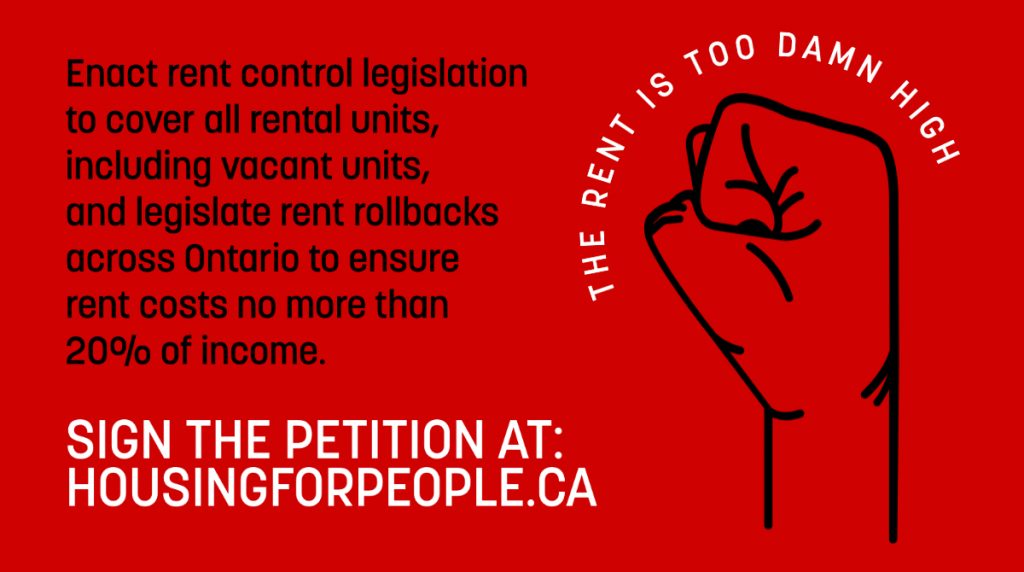
Accelerated Austerity
Overall, the Ford government represents the most aggressive sections of capital in the province. They are quite clear in what they want: lower taxes on corporations and the wealthy, a weakened working-class movement and the defunding and privatization of social services, health and education. The less the government taxes and spends, the better their profits, and the worse for workers’ social wages and the most vulnerable sections of the population.
The prospect of more austerity policies and cuts are truly terrifying. Ontario spends less on government programs per person than any other province in Canada. Despite the Conservative propaganda about “wasteful spending” under the Liberals, Ontario was still at the bottom of the list of provinces for spending before Doug Ford was elected in 2018. Corporate austerity is not new to Ontario.
The pace and scope of the cuts is escalating. Along with the cuts from twenty-five years of austerity already crushing the working class, current cuts are pushing various crises into a new critical stage.
The Ford government has tried to justify massive spending cuts across the board by fomenting lies and distortions about the government deficit. However, cuts are not being used to pay down Ontario’s relatively modest deficit but to cut revenue instead. We saw this clearly in the first couple years of the Ford government. Tax cuts brought in by the Ford government were already costing $6.6 billion by 2020, with more tax cuts, subsidies and bailouts promised.
When the pandemic hit, the government was forced to step up with increased funding in a variety of areas. The government is now busy removing the meagre supports they put in place in 2020 to stop the total collapse of the health and education systems.
To keep pace with population growth and inflation, without cutting already inadequate services, the province would need to increase spending by tens of billions of dollars. Instead of projecting this, each new Ford budget contains new tax cuts and revenue cutting measures.
The “K shaped” nature of the economic “recovery” has been widely reported. Ontario’s biggest corporate monopolies and wealthiest individuals have been successfully profiteering during the health crisis. However, without a massive fight from the working class and its allies, there will be no tax increases for those that can afford to pay. The government looks set to double down on austerity to ensure that working people pay to recover post-pandemic corporate profitability. There are major struggles ahead to fight for a people’s recovery.
Health
The pandemic revealed that Ontario’s health and long-term care systems had been decimated by successive provincial and federal governments which cut funding, privatized and failed to enforce the Canada Health Act. Just before the pandemic began in 2020, there were 1.4 acute-care hospital beds per thousand people in Ontario, with the Canadian average being two per thousand and Germany averaging six per thousand. The pre-pandemic wait time for a hospital bed was 18.3 hours, up sharply from 14.4 hours when the Conservatives were elected in 2018.
The Ford government has also worked to restructure Ontario’s health care system in order to privatize it further. This harsh austerity and restructuring in health have accelerated the drive towards privatization. The “Hospital Restructuring Act”, passed in 2019, sets up a centralized Super Agency to replace the fourteen LHIN networks, Cancer Care Ontario, Health Quality Ontario, the Trillium Organ donation system and many other health care services in the province. The legislation gives the Minister of Health enormous powers to order mergers and transfer and close services. It is the most severe restructuring of health services in the recent history of Ontario and is designed to give a Super Agency, stacked with corporate free marketeers, the power to privatize. Further privatization of health care has already started with the government’s home care bill in 2020 which removed home care from public oversight and facilitated contracting out to provider companies.
While claiming to be spending more money on health, the province is in fact imposing real-dollar cuts to health care, with funding increasing at less than the rate of inflation and population growth and ignoring the needs of the aging population. In May 2021, Ontario’s Financial Accountability Office (FAO) reported that the government’s projected funding increase of 2% annually for the next ten years falls well short of the increases of the previous decade of austerity of 3.2%. Ford is legislating massive cuts at a time when the system is in crisis after 25 years of starvation and suffering from the trauma of the pandemic. While campaigning on “ending hallway medicine”, the Ford government has proceeded to implement massive cuts to health care which will only exacerbate the crisis. A wrecking plan to privatized health care is underway.
Ontario has a history of providing poor mental health services to residents even pre-pandemic, including: a lack of or inadequate coverage for psychotherapy or counselling under OHIP, long waiting periods to receive mental health care, and lack of experienced mental health professionals needed to service a growing number of people suffering from major depression, generalized anxiety, panic disorders, addiction, and many other common conditions that are results of working under capitalism. ODSP and welfare services have long waiting periods and are often tied to mental health diagnoses, which can take even longer, while the people who are suffering have no other options. Even before the pandemic, mental illness, poverty, and lack of adequate housing were heavily correlated. This has only exacerbated under the Tory government since the start of the pandemic.
A study by Canadian Mental Health Association (CMHA) has reported the pandemic’s strain on the mental health of Ontarians. Rates of stress, anxiety, and depression have reached all-time highs. The Ford government’s blind eye to the crisis of mental health and addictions by introducing massive cuts on the healthcare budget, and the looming danger of privatization is a recipe for long term disaster.
Despite making heroic sacrifices since the start of the pandemic, risking their own health and safety and putting their lives on the line to care for citizens of Ontario, wages for nurses and other healthcare professionals have remained suppressed under Bill 124 since 2019. Bill 124 interferes with nurses’ ability to collectively bargain. As essential workers, they are not legally allowed to strike, so one of their only options is to leave the profession. The departure of nurses is being called an “exodus” by the Ontario Nurses Association (ONA), the union that represents nurses across Ontario. Facing extreme burnout, PTSD, and increasingly stressful and risky nurse-patient ratios, numerous media outlets are reporting a nursing shortage crisis. Meanwhile, wage-suppression has not impacted other front-line services like police and firefighters. Nursing is a predominately women-dominated profession, and ONA has argued that this is gender discrimination. Bill 124 is sexist legislation that threatens the resiliency of our healthcare system and puts patients at risk.
Education
The Ford government’s most frequent foe has been teachers, their unions and parents. In the spring of 2019, the government tried to increase class sizes drastically which would have resulted in 25% fewer teaching jobs over a five-year period. They also tried to bring in four mandatory online courses per student which would have meant less funding for schools, more layoffs and a further deterioration of the quality of education, along with deep cuts to educational supports and special needs services. The goal was a 3% cut in per-student funding across all Ontario school boards.
The drive towards privatization has also been accelerated by reduced class offerings and mandatory e-learning, forcing more students to take online education, which can be provided by private schools. The recent pledge to continue to expand online education post-pandemic will lead to more privatization, skimming and scandals such as those seen with e-health and telehealth programs.
Additionally, the more recent introduction of the misnamed “hybrid learning” to several school boards further threatens quality public education, where both in-person and online students are simultaneously taught by one teacher. This will inevitably harm learning while also damaging staffing ratios by placing more students in each class. Inevitably, the public’s confidence in the public school system will be significantly eroded, providing an opening for the Ford government to move toward different forms of privatization, such as US-style charter schools – the most recent evidence showing that virtual charter “schools” are among the worst performing segments of the education sector in that country.
The increasingly unpopular education minister Stephen Lecce, a private school graduate, has been forced to partially back down on some of the worst aspects of the government’s plan to attack education. This was largely due to job action including rotating strikes by teachers in late 2019 and early 2020. It became clear that the majority of the public was on the side of the teachers. After the pandemic disrupted the teachers’ momentum, they were forced to make concessions on wages in line with Bill 124’s public sector wage cuts, a class size rise to 23 from 22, and two mandatory online courses for high schools, however these have an opt-out process. The government was originally demanding a class size average of 28 and four online courses, so the unions managed to beat back the worst of the attack.
Pandemic funding, inadequate as it was, is also being removed from public education. Lecce and Ford have been promising for over a year to announce a comprehensive plan to get children safely back to school. Instead, they have announced they will be making sure that online education continues to expand post-pandemic. There is no budgetary commitment to reduce class sizes or ensure better ventilation in schools. The government has committed to fund education at a level that is not projected to keep up with inflation and enrolment growth, meaning real and significant long-term cuts to our children’s education. Indeed, in his most recent fall 2021 economic update, Doug Ford cut $500 million from the education budget for this school year. The results will be devastating for an already threadbare system.
Massive cuts and neoliberal restructuring to post-secondary education (PSE) is well underway in Ontario. In 2019, the Ford government announced a 10% reduction in tuition fees as a veil to introduce massive cuts to grants. Even with the 10% reduction in 2019, tuition fees in Ontario are still the third highest of any province in Canada at around $8,000 on average for an undergraduate university program a year. The tuition fee cut was not accompanied by additional public funding resulting in $440 million of lost revenue to PSE which resulted in added pressure on school administrations to deepen cuts to programs and privatization. The slight reduction in fees was accompanied by a $600 million dollar cut to grants, impacting working-class and low-income students the most.
Worse still, the government moved towards a “performance-based” funding model for post-secondary education. This market-based performance funding ties 60% of all funding to arbitrary “skills and job” outcomes, allowing for public funds to be allocated more towards education that produce workers for particular industries or towards the creation of profitable intellectual property for corporations. This is greatly accelerating the corporatization of post-secondary education.
Increasingly, Ontario post-secondary educational institutions have moved to fill the gap created by provincial cuts with increased tuition and ancillary fees, and by increasing the proportion of international students admitted, who can pay up to four times as much in tuition fees as their domestic classmates. For the additional fees they pay, these students rarely receive the additional language and social supports they require to succeed in their studies and live comfortably and safely in a new country. This arrangement is highly exploitative, and it both feeds off and reinforces colonialist patterns of global inequity and uneven development. Furthermore, as the disruption to international travel provided by the pandemic demonstrated, it is hardly a sustainable solution to the funding shortfall.
The funding crisis in PSE exploded with Laurentian University declaring bankruptcy in early 2021. Academic programs were cut affecting 800 students and 150 faculty and staff were laid-off. The Laurentian administration, in collusion with the provincial government, used the federal Companies Creditors Arrangement Act (CCAA) to impose an unprecedented restructuring campaign on this Northern Ontario university. The CCAA has been used against labour in the private sector to steal the unpaid wages and pensions of workers and ensure banks and corporate creditors are paid back first, but this is the first time a public institution has used it, setting a dangerous precedent for the whole public sector. Laurentian and the provincial government decided to fix a problem caused by decades of neoliberal funding cuts and privatization by doubling down on even more brutal neoliberal restructuring.
The big picture here is that government funding to Ontario universities dropped from about 80% of operating revenues in 1980 to about 50% in 2004 and to just over one-third in 2017. Unless this trend is reversed, other schools will be forced to gut programs and lay off faculty and staff in order to survive. Some will not survive.
Climate Change and the Environment
Two general capitalist policy approaches have emerged in regards to climate change: green washing measures which seek to maintain corporate profits on the backs of working people during a transition to a “green” economy, or almost complete inaction. The Ford government currently belongs to the latter category. The Conservatives have moved quickly to gut already inadequate environmental and climate programs, in order to open the province to vastly increased corporate access, development, and profit. At the same time, the Tories are also pushing aggressively to expand nuclear power development, which they are packaging as part of the solution to the climate crisis. This includes the $13 billion small modular reactor (SMR) being built at Darlington generating station.
In late 2020, Ontario’s Auditor General released a report saying that the Province may not meet its 2030 emission-reduction targets, which were set to meet Ontario’s obligations under the Paris Agreement. As part of his “first 100 days” Ford cancelled all provincial climate change plans including cap-and-trade, home and small business energy retrofit programs and the Greenhouse Gas Reduction Fund. His government removed the requirement that carbon emissions targets be set in law and cancelled over 750 renewable energy projects throughout Ontario, including decommissioning the nearly completed White Pines wind turbine project in Prince Edward County.
The gradual and increasing privatization of power generation, transmission and distribution has a significant effect on the power bills paid by the consumer and some industries, and on the revenue and capital that can be generated for public welfare and development. There is currently legislation restricting Ontario Power Generation from directly investing in newer forms of energy. At the same time, the government is closing plants and has no plans to build new generation capacity. There will be increased demand associated with the introduction of new electrical vehicles. The resistance against Ontario’s energy policies has been muted, due to significant direct government subsidies to bills, but continues to fester in the background.
Ford has also allied himself with right-wing premiers in western resource-based provinces in calling for immediate pipeline construction to benefit the tar sands, and in opposing even tepid, business friendly federal climate programs such as Justin Trudeau’s carbon tax.
The Ford government passed Bill 197 in the summer of 2020. This is a piece of omnibus legislation that, among other things, guts the Environmental Assessment Act and violates the Ontario Environmental Bill of Rights with the enthusiastic backing of large developers. The government will now decide which projects need environmental assessments. Bill 197 also eliminates the key mechanism that allowed for the public to ask for a full review of a particular project and the bill allows for the bulldozing of opposition through new ministerial zoning orders (MZOs). These MZO’s allow the complete circumvention of the normal environmental consultation process taking place before development is permitted in Ontario’s threatened wetlands and other ecosystems and pose a fundamental threat to biodiversity and the preservation of the many endangered species making these areas their home.
A particularly contentious, fast tracked development proposal is the GTA West Corridor highway and transitway (Highway 413). Instead of investing in efficient public transit to link the outer areas of the GTA, Ford is pandering to a group of land developers with large properties along the proposed site of the highway. These opportunists have all donated to the PC Party, lobbied that party, and expect their properties to exponentially increase in value with the addition of the corridor. The project would further infringe on the self-determination of Indigenous people, estrange and demolish existing communities in the highway’s path, destroy conservation areas along the Greenbelt and pave over prime farmland. The Ford government’s sustained enthusiasm concerning this project fits squarely within their policy of climate change inaction at the expense of people and biodiversity in the GTA.
Urgent action to protect Ontario’s ecosystems and stop climate change cannot wait for a “return to normal” in post-pandemic world. Oil and gas monopolies and other industries that are the main sources of carbon emissions are demanding even more state subsidies and bailouts. Now is the time to transition to a publicly owned and delivered renewable energy industry. More than 130 forest fires in North Western Ontario are raging and displacing First Nations while the Ford government refuses to declare an emergency. Warmer winters have caused crucial ice roads into fly-in communities to form later and in shorter durations, disrupting key routes into Northern communities that would otherwise only be accessible by costly flights. It is clear that the climate is changing right now and the effects are already having deadly consequences. When the Conservative austerity and deregulation agenda is applied to the environment the result is a policy of climate denialism. This is an existential threat to all.
Democracy & Equality
This government is part of the reactionary movement against hard-won labour, equality and democratic rights. The Ford government has repeatedly shown itself ever-ready to trample the inadequate legal limits to the government’s power and ignore democratic norms. The Conservatives have gone after the labour movement, student movement, municipalities and Indigenous nations in an effort to roll back democracy to empower themselves and their corporate backers.
The labour movement has been in the cross hairs of this government. Bill 124, the sweeping public sector wage cut bill, tramples the rights of all workers and unions in Ontario to free collective bargaining with their employers. In spring 2021, the Ford government used the constitution’s notwithstanding clause for the first time in Ontario’s history to force through an anti-democratic electoral reform package that was struck down by the courts only days before. The electoral reform itself is an attack on democracy which has doubled annual donation limits and placed further limits on labour’s ability to spend funds and have any influence on elections. With this move, Ford showed that he is willing to use brute force to pass illegal legislation for narrow partisan, particularly corporate, interests.
The government has also attacked democracy at the municipal level. Soon after forming government, Ford cut Toronto City Council in half and replaced some elected heads of councils with appointees. In 2020, Ford repealed the option for municipalities to use ranked ballots in municipal elections, blocking even the most timid step away from the undemocratic first-past-the-post electoral system.
At the same time as they brought in massive cuts to student grants in 2019, the Conservatives introduced the so-called “Student Choice Initiative”. The goal was to allow students to opt-out of paying fees to student organizations that were democratically decided through student referendums on campuses. This “right-to-work” style policy was designed to destroy student unions, gender and sexuality centres, Public Interest Research Groups, campus newspapers and radio, and other independent, progressive student organizations. The youth of the Conservative Party had been trying to defund these groups on campuses for a long time by running referenda on campuses. Collective student decision-making over their own organizations was attacked and student organizations struggled to stay afloat during the Fall of 2019 when the changes were brought into effect. Fortunately, the student movement won a court challenge and funding was restored in 2020, however the Ford government may try and bring the same policies in through legislation.
The Ford government has continued Ontario and Canada’s long history of trampling the rights of Indigenous peoples. The main goal of governments continues to be unfettered access to Indigenous land and resources in order to further enrich the monopoly corporate interests the state serves. The Ontario government is fairly obvious in this approach with the Minister of Indigenous Affairs being the same man as the Minister of Energy, Northern Development and Mines. The Ontario government slashed the budget of Ontario’s Indigenous Affairs in half from $146 million in 2018 to $74.4 million in 2019.
Ford has made it clear that he intends to push Indigenous rights aside in his pursuit of increased corporate profit. During the provincial election, Ford declared that he would “drive the bulldozer himself” to fast-track the Ring of Fire mining development in Northern Ontario. Ford has been threatening to scrap the Far North Act since 2019 although it is not clear what will replace it. Indigenous peoples make up the vast majority of inhabitants in Ontario’s far north. After resistance and Indigenous struggles for governance authority in the region eleven years ago, the Liberal government brought in the Far North Act which protected forests and “partnered” with First Nations in decision making and revenue sharing. The Act was criticized by the Nishnawbe Aski Nation who called it a “new form of colonialism.” While providing some limited rights, the government’s goal was to push on with development and impose legal limits on Indigenous self-government in the region. Despite the legislation itself being problematic, the government’s new proposals are a definite step backward based on the goal of “reducing red tape” on “important economic development”. Matawa chiefs, representing nine Ojibway and Cree First Nations in Northern Ontario, spoke out in early 2021 against the government forcing through any changes to the act during the pandemic. It should be remembered that First Nations have been poisoned by industry in the recent past. In Grassy Narrows, 90% of the community show signs of mercury poisoning. The Federal and Ontario governments have not cleaned the poisoned rivers even though they have had fifty years to do so.
Haudenosaunee Land Defenders have been holding a land reclamation site for over a year. 1492 Land Back Lane is on a piece of land where Foxgate Developments was set to construct residential buildings until they pulled out in 2021 thanks to the reclamation. The planned development is part of the Haldimand Tract, land that the British colonial government agreed to recognize as belonging to the Haudenosaunee in 1784. This included 10 kilometres on either side of the Grand River. However, the Six Nations of the Grand River now has less than 5% of this land. During this ongoing struggle, the Ford government has chosen to fuel racism and encourage police violence. After the police attacked the land defenders with rubber bullets and tasers and made thirty arrests the Premier declared that the stand-off had been caused by “a few bad apples”. Ford also unironically commented that “you just can’t go in and take over people’s future homes,” and that he was going to “protect police”. The cause of the current situation is not “bad apples” but centuries of ignoring land rights agreed to in treaties, decades of ignoring land claims, and when resistance surfaces, using police to brutalize Indigenous peoples. The role the Ontario government has played has been to encourage police violence, land theft and the continued erosion of treaty rights.
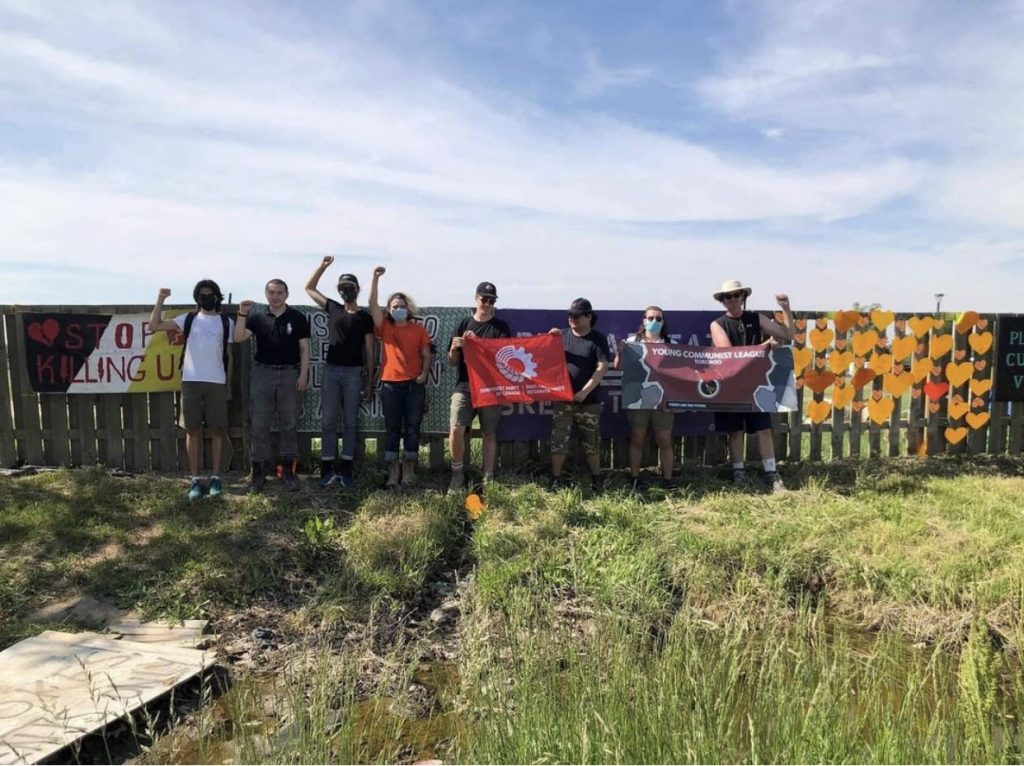
In December 2020, Bill 156 came into enforcement. The Security from Trespass and Protecting Food Safety Act is a direct attack on animal rights advocates and those who would expose the horrors of factory farming practices in Ontario. This law threatens anyone who would question industry practices in agriculture, including labour rights advocates working to lift the curtain on worker abuse in the industry. The law has already led to multiple arrests and charges, and one activist has been killed while picketing. Bill 156 is exemplary of the intersection of environmental and economic abuse under capitalism, and the role of the bourgeois state in perpetuating these abuses in the interests of private profit.
The Ford government’s connections to ultra-right, racist and fascist forces continue. We should remember Doug Ford’s reluctance to disassociate himself from Faith Goldy, a white nationalist and Islamophobic media personality who came in third place in the last Toronto mayoral race. In 2020, the Ford government planned to give Charles McVety’s Canada Christian College, university status and degree granting authority, despite it being a private, reactionary, religious institution. Charles McVety, a longtime Conservative supporter and close supporter of Ford’s election, has repeatedly used his institution to promote Islamophobia, racism, misogyny, homophobia and transphobia. Fortunately, the clear cronyism behind Ford’s plan led to enough resistance to have McVety’s application to become a university denied.
Doug Ford’s so-called “Free Speech” policy towards universities and colleges was a dog-whistle to ultra-right forces. The policy threatens post-secondary institutions with defunding if there are checks on hate-speech activities on campus, including anti-hate protests organized by students. These policies were used to pressure student groups to include the racist People’s Party in election debates during the federal election. At the same time as Ford was defunding progressive student organizations, his government was opening up schools to ultra-right organizing.
The Ford government’s attacks on equality rights also include their attacks on the Franco-Ontarian community. In 2018, the government eliminated the Commissioner of French-Language Services and suspended plans for a promised French-language university in Toronto. This resulted in a defection of a Franco-Ontarian PC MPP to the Liberals and a massive mobilization of Franco-Ontarians against the government. Ford was forced to recreate the position of language commissioner, but he suppressed it inside the office of the Ombudsman with a reduced mandate and powers. The French language university is rolling ahead slowly, but another attack on French language education took place with the Laurentian bankruptcy in 2021. Laurentian remains an important bilingual university located in the north of the province where there are large Francophone communities. Despite this, an astounding 45% of the French-language programs have been cut. Ontario is only now opening their first French speaking university in Toronto, while the English-speaking population in Quebec (which is comparable in number to the number of French speakers in Ontario) has three primarily English universities and seven English CEGEPs.
The Ford government has consistently shown why it has been supported by ultra-right and racist forces. This is a government that is quite willing to cater to Anglo-chauvinism and ignore the rights of Indigenous nations and the Franco-Ontarian national minority.

Limited opposition at Queen’s Park
There is no question that the Ford Conservatives are the biggest danger to working people in Ontario. While it was the Liberals who laid much of the ground work – partly through their own programs and partly by building on the foundation laid by the Harris/Eves Conservatives before them – this is a government that has accelerated the austerity agenda and is more willing to run roughshod over democratic rights.
The 2018 election was more of a referendum on fifteen years of Liberal Party government in Ontario than a ringing endorsement of Ford’s agenda. Ford concealed much of the Conservative program with an empty anti-Liberal election campaign. However, by 2019’s deep austerity budget, the majority of the working class was aware of the true intentions of the Tory government and his approval rating plummeted to 30%. In a December 2019 poll, Ford ranked last in popularity among all Premiers in Canada.
The pandemic briefly brought new life to Doug Ford’s popularity with corporate media pundits lining up to contrast Ford favourably with Donald Trump’s disastrous press conferences on COVID-19. However, the second honeymoon didn’t last. By the fall of 2020, it was clear to all that the government had ignored public health officials and done less than the bare minimum to avoid a second wave in LTC and schools. By the peak of the third wave, with calls for paid sick days growing and Ford’s disastrous announcement about expanding policing of a stay at home order, no amount of comparing him to Trump would convince people he was doing a good job.
Despite Ford and the Conservatives’ downward trend in popularity, the Ontario Tories are receiving significant support for their corporate agenda from the capitalist class. Clearly big money is still bankrolling the Ford steamroller. Ontario PCs brought in twice as much fundraising than the Ontario NDP in 2020 and almost twice as much as the Liberals, and they accomplished this before they increased donation limits in 2021.
Three polls in June 2021 seem to point to an unpredictable 2022 election: the PCs are still in the lead with between 33 and 36% support, compared to between 26 and 27% for the Liberals, 25 and 28% for the New Democrats and between 6 and 9% for the Greens.
In fact, there has been little opposition in Queen’s Park. The opposition parties are not focused on the big picture corporate agenda of the Ford government, and there is no clear working-class perspective being consistently represented inside the legislature. Andrea Horwath and the Ontario New Democrats have adopted a “play-it-safe” strategy that celebrates their substantial seat increase in 2018. They are playing the “government in waiting” until 2022, and worse still, some in the labour and people’s movements have been convinced that they just need to wait in order to win a “progressive government”.
While speaking up against privatization of health care and education cuts, the New Democrats are not offering an alternative program that challenges corporate power. The ONDP have rejected mass labour and people’s mobilization and instead have tried to position themselves as more responsible stewards of capitalism with a human face. This can be seen by their current policy paper “Ontario’s Green New Democratic Deal” that is largely devoid of policy besides some public subsidization of a green transition of private industry. The ONDP has backed away from expanding and introducing universal, quality, public programs. Their dental care plan is not a universal public system but will require employers to provide a minimum standard of coverage. Their housing strategy uses market mechanisms like inclusionary zoning, already shown to increase gentrification, instead of any commitment to build social housing. Their day care proposals are based on a sliding scale cost to families – not universally accessible to all. The ONDP’s proposals look like slightly better versions of the Liberal Party’s neoliberal, piecemeal, means-tested social program approach. They are hoping to replace the Liberals, and as such are courting business’ support.

More fundamentally, the social democratic roots of the NDP have always been based on class compromise as opposed to class struggle. They have abandoned some of the traditional demands of social democracy, even if much of their labour base still support these policies. What is necessary is not a return to a less compromised social democratic party, but a genuine People’s Coalition built through struggle in the streets and workplaces with a parliamentary reflection.
With the NDP trying to avoid rocking the boat, it is no wonder that the Liberal Party has seen a resurgence accompanied by support from sections of big business. Two by-election victories and the recruitment of former Tory MP Amanda Simard have also helped the Liberals. Despite the NDP having 40 seats to the Liberals’ 8, the Liberal Party and the ONDP have been neck and neck in the polls since 2019.
Working people in Ontario should not be confused by a rebranded Liberal Party under their newly elected leader Steven Del Duca. Del Duca is a career Liberal, an aide to McGuinty and a Minister under Wynne. We can only expect continuity from the Liberal party who did not live up to their promise of reversing most of the cuts of the Harris years. Instead they enforced fifteen years of austerity through a slow boil strategy. The austerity by attrition approach of the Liberals may seem preferable to the Conservative slash and burn strategy of the current government, however the working class can afford neither, and a sharp break with corporate power is necessary to address the deep capitalist crises we are currently facing.
A duck-and-cover approach by labour and people’s movements that waits for the self-destruction of the Ford government during the next election, will likely result in the election of the Liberal Party again, or possibly the Ontario Progressive Conservatives. Even if the ONDP were able to win, their weak reformist proposals will not address the deep capitalist crises we are currently facing. It is clear that labour and people’s movements cannot afford to wait for the election but must take action now in the build-up to next year’s election.
The working class must take action now to demand a fundamental break from corporate austerity and to win progressive reforms such as those in the Communist Party’s People’s Alternative for Ontario. To popularize our program and strategy, the Party must do everything in our power, where we can run candidates and where we are active in labour and mass movements, to push for these policies and demonstrate that another Ontario is possible and worth fighting for.
Building a People’s Coalition for a People’s Recovery
The good news is that people are ready to fight and there have been inspiring mobilizations and struggles against the corporate agenda in Ontario since our last Ontario Convention. However, much more must be done in the labour and peoples’ movements to link struggles, build unity and mass escalating action to win a People’s Recovery.
The Ontario Federation of Labour under Chris Buckley’s leadership almost a year to respond to the Ford government’s election. They convened a large conference to begin their “Power of Many” campaign. Although some hoped at the time that the “Power of Many” would be a labour-led coalition against the Ford government that would be used to coordinate and build mass action, the campaign has simply been a branding of any OFL and large affiliates’ actions or statements against the Ford government. In retrospect, the hope that many well-intentioned labour activists felt in the “Power of Many” Ontario-wide conference in early 2019 was misguided and may have actually blocked other coalitions that might have emerged.
Fortunately, not everyone waited for the OFL to take the lead in resisting the Ford government. The 2019 budget cuts set off a new sense of urgency in the fightback. Spontaneous reaction to cuts to post-secondary student grants led to a mass march of thousands in Toronto in late January. Teachers’ unions organized a mass rally at Queen’s Park on April 6th, 2019 involving tens of thousands of teachers, students, parents and community. This action was greatly bolstered by the estimated 100,000 elementary and high school students that walked out of their schools on April 4th.
Around the same time, the Ontario Health Coalition organized a massive rally on April 30th, 2019 with at least 10,000 participants to fight cuts and the privatization of healthcare. These mobilizations and others forced Doug Ford to go underground through the summer and fall of 2019 during the federal election campaign as his popularity plummeted. The fightback helped to isolate and block the federal Conservatives as they failed to gain traction in Ontario in the October election. This showed that mass resistance is possible and effective against this Conservative government.
The teachers and education workers’ strikes beginning in late 2019 were in many ways the high-water mark in the fight against Ford lasting until the spring of 2020 and the beginning of the pandemic lockdowns. Poll after poll during the strikes showed that a majority of Ontarians were with teachers and education workers in opposing the Ford government’s cuts to education. The rotating strike strategy, led mainly by the Ontario Secondary School Teachers’ Federation (OSSTF) and the Elementary Teachers’ Federation of Ontario (ETFO), was able to avoid anti-democratic back-to-work legislation while building community support and solidarity.
February 21st, 2020 saw two million students out of class as close to two hundred thousand teachers and other education workers held a coordinated strike. Members of ETFO, OSSTF, the Ontario English Catholic Teachers Association (OECTA) and l’Association des enseignantes et des enseignants franco-ontariens (AEFO) were all off the job together for the first time since 1997, in a show of nearly unprecedented unity.
The tentative deal by OECTA with the government broke that unity in early March and the pandemic caused the strikes and job action to lose momentum. However, the experience showed that education unions were successful in linking their members’ struggles for jobs and working conditions to the learning conditions of students and the quality of Ontario’s public education system.
The OFL Convention took place in the middle of the teachers’ and education workers’ struggle in late 2019. The action plan adopted by the OFL Convention called for a strengthening of their “Power of Many” campaign but again it was not clear how the campaign would become an effective coalition uniting labour and people’s movements. Much of the action plan was focused on building labour’s capacity in “swing-ridings” and recruiting volunteers for the ONDP’s election campaign in 2022.
The election of executive incumbent Patty Coates as President in 2019 suggested a continuation of the stagnation of the OFL that set in after affiliate leaders conspired to remove the social unionist-oriented leadership of Sid Ryan in 2015. However, the election of Janice Folk-Dawson from CUPE Ontario as Executive Vice President has helped the OFL leadership take a more engaged role in the fightback and the Federation has adopted a more social unionist approach since the 2019 Convention. The OFL is more regularly participating in solidarity with Indigenous movements, migrant worker organizing, and anti-racist movements.
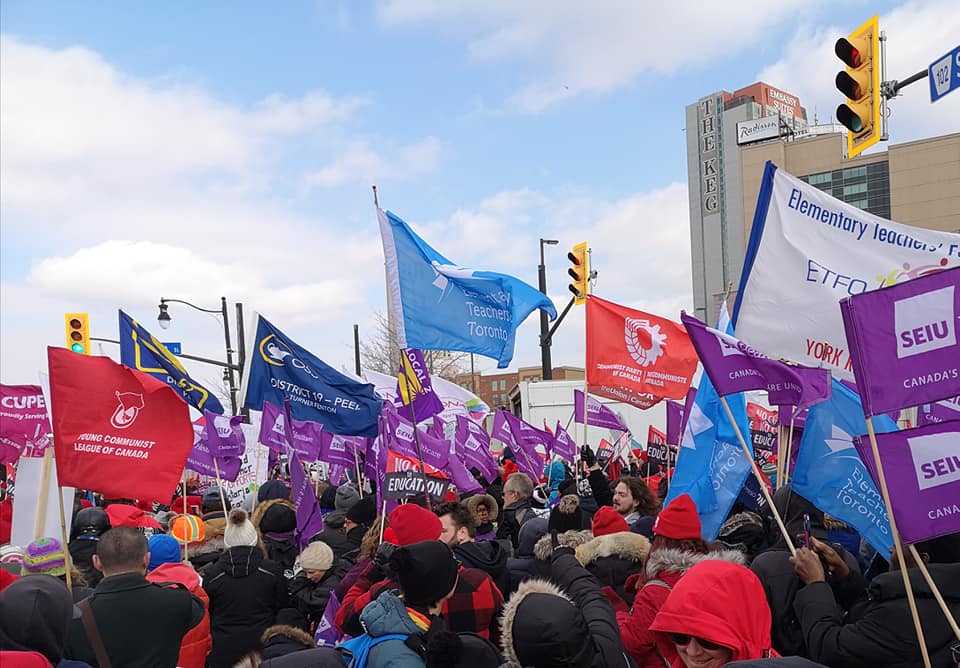
The OFL played a central role in organizing it’s first and only mass demonstration against the Ford government on February 22, 2020. Five thousand union and community members protested the Ontario Conservatives’ “2020 Conference” in Niagara Falls. Labour councils, the OFL and affiliate unions organized buses from as far away as Ottawa and Timmins to the “People vs. Conservative Cuts” rally. Although clearly necessary from the outset, the OFL’s “Power of Many” campaign had not attempted a large mass action involving broad mobilization across labour prior to this. Unfortunately, the pandemic lockdown measures complicated calls for any mass action for the next year and any momentum building in the Winter of 2020 was largely lost.
These were positive steps forward for the OFL, but there is still a long way to go for the OFL to assume their role in leading the broader labour movement in escalating mass action. The OFL’s political action is tied directly to the NDP, and the countdown clock to the next “election and a progressive government in Ontario” is still a main feature on their website. If the clock strikes zero without the OFL taking meaningful independent mass political action, the actual chance of a “progressive government in Ontario” is slim. The Alberta Federation of Labour has shown some real organized fightback recently, including through provincial wildcat strikes by hospital workers against the Kenney Conservative government in 2020. It is this unity and militancy that is needed in Ontario in order to defeat the Ford government’s corporate agenda for Ontario and to win key pieces of a People’s Recovery.
Recent organizing around a left caucus inside the labour movement has shown promising signs. Many trade unionists have participated in recent organizing meetings of the Action Caucus and it played an important role at the CLC in defeating anti-democratic constitutional amendments. Those getting involved in the Action Caucus, many for the first time, realize the immediate need for mass, independent, labour political action. We salute these important steps forward and will continue to support these efforts. We must now bring this organizing model to our local labour councils across the province. And there is new leadership at the Toronto and York Region Labour Council. As the first black woman to assume the leadership of the largest labour council in the country, President Andria Babbington has a history of grassroots organizing, successful record of working in coalition and a keen and lived understanding of oppression. She has already stated that her goal is to broaden and activate workers and communities across the region.
Pandemic organizing demonstrated the strengths and weaknesses of labour and people’s movements. It was shocking, but perhaps not surprising, that much of the labour movement was paralyzed by their right-wing leadership while workers experienced the pandemic first-hand, including many who died. The CLC, Unifor and other unions welcomed the CEWS program, a massive wealth transfer from the public purse to monopoly corporations, for the seemingly narrow self-interest of being able to collect dues if their members were still on the payroll as opposed to CERB/CRB.
However, there were inspiring signs of struggle under the difficult conditions of the pandemic as well. Widespread spontaneous resistance occurred amongst healthcare workers and other essential workers who were fighting for access to decent PPE and health and safety. Work stoppages occurred in construction, garbage collection, public transportation and more. Health care workers across the province spoke up and mobilized against Ford’s inadequate and dangerous public health policies. The Ontario Health Coalition (OHC), which our party and many unions and local coalitions belong to, has done an excellent job in researching what is going on in the healthcare sector and holding car cavalcades and online rallies during lockdowns.
We need to build on our efforts to support the OHC and local coalitions, since the pandemic is not over, and the weaknesses in our health and long-term care systems have been exposed for all to see. A key campaign in this area is the fight to make Revera long-term care corporation public. Although a for-profit LTC operator, Revera is 100% owned by the Public Sector Investment Board, a crown corporation that invests the pension money of the federal public servants, the RCMP and the military. The largest public-sector union, the Public Service Alliance of Canada along with fourteen other federal public sector unions have endorsed the campaign. The Ontario and Canadian Health Coalitions helped to organize a country wide campaign tied to the 2021 federal election.
Indigenous peoples have been fighting back and winning new consciousness and solidarity among Canadians in the recent period. The heroic efforts of the Wet’suwet’en people and their hereditary chiefs to enforce their rights to sovereignty, self-determination, land and title rights in early 2020 inspired country-wide solidarity with Wet’suwet’en from other First Nations and non-Indigenous peoples. Later in 2020, the Haudenosaunee reclamation site of “1492 Land Back Lane” was established to block new housing developments that would continue the theft of the Haldimand Tract land promised in 1784. Solidarity poured in from across the province and labour delegations made frequent visits to the site helping to discourage police from attacking.

When 215 First Nation children’s remains were discovered at a residential school site in the Tk’emlúps te Secwépemc territory Canada’s genocidal history and present was laid bare and mass actions took place across Canada including Ontario. Thousands more bodies have been discovered since and continue to be uncovered prompting more shock among the mainstream media and settler and non-Indigenous population, although Indigenous peoples have been saying these unmarked graves existed for decades. As many more people in Canada were brought to awareness regarding the brutality of colonialism, July 1st became a day not for celebrating Canada, but for commemorating the many lives lost at residential “schools”. The last two years especially have shown that more and more people are willing to stand with Indigenous people despite vicious racism, misinformation campaigns, and genocide apologia by the corporate media and right-wing politicians. The militancy and unity of Indigenous peoples and as well as solidarity in the struggle for Indigenous sovereignty and self-determination continues to grow.
While there are many who would like to dismiss the mass graves of Indigenous children as an error made in the past by their predecessors, Indigenous peoples have been clear in pointing out the continuity in regard to Indigenous children’s welfare. The children of Indigenous peoples continue to be used by the state as a battle ground in their ongoing fight against Indigenous sovereignty. The intentional impoverishment of Indigenous peoples continues to allow the government’s institutions to remove Indigenous children, who are over-represented within the welfare system, from their communities.
One of the high points of mass mobilizations in North America in recent years took place in June 2020 as a mass uprising against racist police murder and brutality was sparked by the murder of George Floyd by Minneapolis police in late May. The movement quickly spread to Canada and around the world. In Ontario people fought for the recognition of racist policing in this province. In the summer of 2020, marches and rallies demanded justice after the deaths of D’Andre Campbell, a Black man, who was shot by police inside his home after being tased in Brampton in April, Regis Korchinski-Paquet, a Black-Indigenous woman who fell to her death in the presence of Toronto police, and Malton resident Ejaz Choudry, who was shot and killed by police in June. Of particular note is that in all of these cases, the victims were in the throes of a mental health crisis, but it was the police who were directed to the scene by 911, not trained mental health or medical professionals. In October 2020, Anthony Aust fell from a window and died as a direct result of a no-knock dynamic entry by Ottawa police.
Police impunity is a major problem born from racialized inequality seen right across Ontario. Northern cities and towns suffer at the hands of anti-Indigenous police violence. The Thunder Bay Police Service has been the subject of multiple reports describing systemic racism after it became clear that the police were ignoring murders and deaths of Indigenous people in that city. These incidents and many others have underlined the need to defund and demilitarize the police and shift funding towards social spending. Despite pushback from the Province and right-wing dominated city councils, the Communist Party continues to fight for defunding the police and putting police under real, independent, and direct civilian controls with teeth.
Tenant unions and housing justice organizations have also become more active as the housing crisis reaches a new level of unaffordability, mass evictions becomes the norm and homeless encampments grow across the province. Some rent strikes have been organized and networks have formed to physically disrupt evictions. Labour councils in Guelph, Durham Region and Toronto have passed resolutions to support tenants, demand the repeal of Bill 184, ban evictions, renovictions and foreclosures, bring in comprehensive rent control, and eliminate vacancy decontrol. There is a real need to link up defensive battles against evictions with mass political action for policies that recognize housing as a human right. We must demand permanent rent-geared-to-income social housing (where rent is based on 20% of household income) be built to meet the needs of underhoused and homeless populations. There is a large objective foundation upon which to build tenants unions and connect labour to the housing struggle
While the student movement saw some semi-spontaneous mobilizations against Ford’s major offensive against PSE in 2019, the student movement has been at a low level of mobilization for the last few years. The Student Choice Initiative targeted student unions and organizations at a time when they were weak after years of attacks from right-wing students and the acceptance of a “duck and cover” approach by social democratic student leaders. The Canadian Federation of Students, still the only independent progressive student federation in English Canada, has not mobilized any day of action since 2016 and has largely relied on lobbying efforts. While many students, and some of their unions, are on the front lines of the climate justice movement, anti-racism movements and Indigenous solidarity, struggles beyond individual campuses are hard to find. The fight against privatization and corporatization of PSE and for free, accessible, quality and emancipatory education is more necessary now than ever in the context of the Ford government. The dire situation in the student movement must be remedied as it is a key component in the fight against the corporate agenda in Ontario.
Fortunately, there have been large mobilizations of elementary and secondary school students in the recent period showing a new militancy. September 21, 2018 saw a mass walkout by 40,000 high school students to condemn the Ford government’s regressive changes to their sex ed curriculum and the cancellation of updates to Indigenous history curriculum. Then in April 2019, 100,000 elementary and high school walked out again to protest the education cuts in the 2019 budget. These two massive events accompanied by other mobilizations of high school students connected to climate justice movements has shown that young people are as prepared as ever to fight.
When the Toronto District School Board attempted to discipline and suspend equity worker, Javier Davila for circulating Palestinian resource material, hundreds of activists mobilized and exposed the injustice of this employer. According to Desmond Cole, “Anti Palestinian racism is a feature of schools all across Canada”. He was accused of making harmful and violent statements for saying “free Palestine.” Independent Jewish Voices states that unlike a decade ago, we are witnessing a growth in analysis around genuine anti-Semitism and the fact that criticizing Israel is not being “anti-Jewish.” We also see greater awareness of the need to support the Palestinian liberation movement against the apartheid settler-colonial Israeli state.
While people’s movements against racism and anti-police brutality have started to find their feet in the recent period, reactionary movements have also found a resurgence with the spread of anti-science myths and resistance to public health measures. The lack of economic support in place for the millions affected by the pandemic has created fertile soil for those on the ultra-right who peddle conspiracy theories with the easy solution that we should ignore the pandemic. Many of these movements are directly connected to racist and ultra-right movements, seeking to divert people away from a systemic analysis of capitalism and towards convenient scapegoats: Muslims, Jews, China, BLM, Women, Trans people, “Critical Race Theory”, Antifa, Communists, etc. While Trump may be at least temporarily away from the levers of power, the ultra-right and fascist forces that followed him are not defeated and still exist in the USA and in this country. It is essential that these forces are isolated, defeated and that people are brought to understand that there is a real alternative to capitalism and the harm it inflicts on them and their communities.
Social justice discourse was swiftly co-opted by corporations, the state, and the military in Canada, the US and elsewhere as a display of “commitment” to and “solidarity” with Two-Spirit and LGBTQI+ and BIPOC communities. These responses have done nothing to meaningfully address either the persisting racism and inequality in these organizations or the needs of the communities that are exploited or destroyed. They do not address the fundamental power structures inherent in capitalism, which the system relies on to maintain profits for shareholders at the expense of the workers, oppressed people and their communities.
The spontaneous and disparate nature of much of the fightback is a serious weakness that must be overcome if we are to defeat the Ford government and roll back the corporate agenda. What we need is the working class to take on the fightback in its own name and on its own terms.
As the capitalist crises continue to deepen, the Communist Party has an important role to play in order to strengthen the fightback, to put forward immediate necessary demands for a People’s Recovery, and to fight for socialism as the only alternative to capitalism. These three tasks are complementary and urgently necessary.




